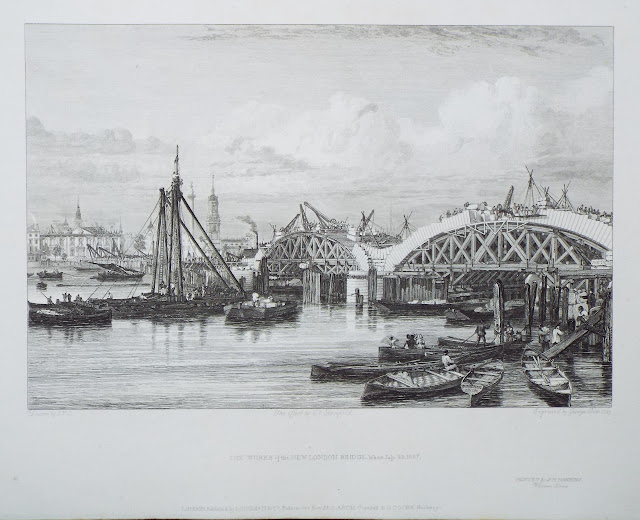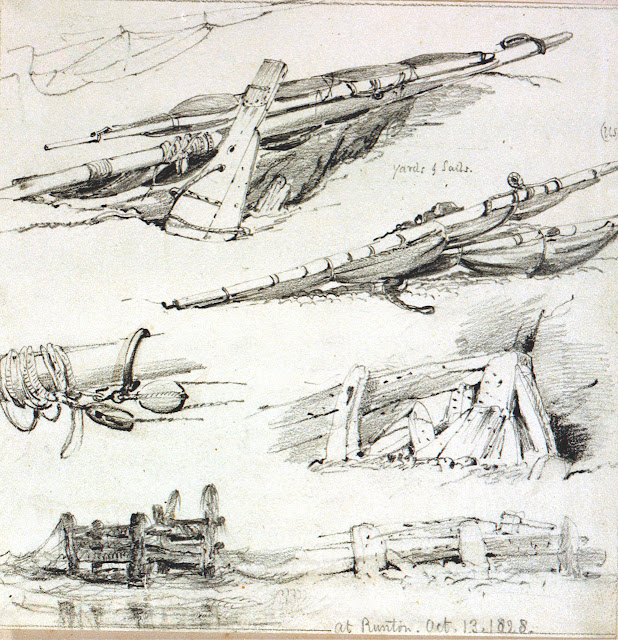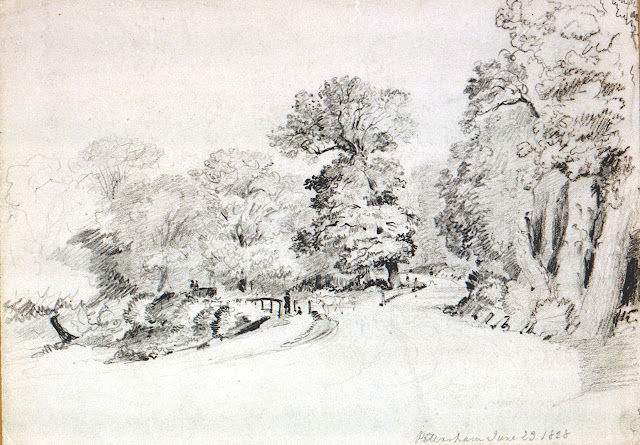 |
| Edward William Cooke R.A. Royal Academy of Arts, London |
Edward William Cooke (1811–1880) was an English landscape and marine painter, and gardener. He was born in London, the son of well-known line engraver George Cooke; his uncle, William Bernard Cooke (1778–1855), was also a line engraver of note, and Edward was raised in the company of artists. He was a precocious draughtsman and a skilled engraver from an early age, displayed an equal preference for marine subjects and published his "Shipping and Craft" – a series of accomplished engravings – when he was 18, in 1829. He benefited from the advice of many of his father's associates, notably Clarkson Stanfield and David Roberts (note: series on Clarkson Stanfield and David Roberts can be found in the index of this blog). Cooke began painting in oils in 1833, took formal lessons from James Stark in 1834 and first exhibited at the Royal Academy and British Institution in 1835, by which time his style was essentially formed.
He went on to travel and paint with great industry at home and abroad, indulging his love of the 17th-century Dutch marine artists with a visit to the Netherlands in 1837. He returned regularly over the next 23 years, studying the effects of the coastal landscape and light, as well as the works of the country’s Old Masters, resulting in highly successful paintings. These included ‘Beaching a Pink at Scheveningen’ (National Maritime Museum, London), which he exhibited in 1855 at the Royal Academy, of which he was an Associate from 1851.
 |
| c1855 Beaching a Pink at Scheveningen |
He went on to travel in Scandinavia, Spain, North Africa and, above all, Venice. In 1858, he was elected into the National Academy of Design as an Honorary Academician.
Cooke was "particularly attracted by the Isle of Wight, and on his formative visit of 1835 he made a thorough study of its fishing boats and lobster pots; above all he delighted in the beaches strewn with rocks of various kinds, fishing tackle, breakwaters and small timber-propped jetties."
He also had serious natural history and geological interests, being a Fellow of the Linnean Society, Fellow of the Geological Society and Fellow of the Zoological Society, and of the Society of Antiquaries. In the 1840s he helped his friend, the horticulturist James Bateman to fit out and design the gardens at Biddulph Grange in Staffordshire, in particular the orchids and rhododendrons. His geological interests in particular led to his election as Fellow of the Royal Society in 1863 and he became a Royal Academician the following year. In 1842 John Edward Gray named a species of boa, Corals cookii, in Cooke's honour.
Cooke visited Egypt in the winter of 1873-4, travelling to Brindisi where he boarded the Simla steamer. En route he met John Fowler and Richard Owen and travelled with them for part of the way. All three stayed in Alexandria in early January before Cooke set off down the Nile on a dahabieh (or houseboat), visiting Feshan, Sohag, Luxor, Karnak, Aswan and various other sites on the way. Cooke sketched as he sailed down the river, and his drawings demonstrate his particular interests in botany and in the variety of sailing vessels to be found on the Nile. He worked at his oil sketches in uncomfortable conditions and his scientific interests dictated some of the subjects'.
In the second edition of his book Leaves from my Sketchbook (1877) Cooke published sixteen plates of Egyptian scenes and in the commentary expressed great admiration for the elegance of the Egyptian dahabieh when he wrote 'a steamer is not a beautiful object anywhere, but...a Nile boat, ... no matter how shabby, always looks well by virtue of the graceful shaped sail'. However, despite the fairly high quality of the plates, Cooke was dissatisfied with the reproductions of his drawings, complaining in a letter that the book had been printed and published 'without my being consulted as to the Plates or the Descriptions - all horribly bad and so black and coarse and vulgar’.
This group of 100 drawings consists of travel sketches by E.W. Cooke. They come from a stock of over 20,000 that the artist produced over the course of his career. Following the early death of his wife in 1844, Cooke developed a peripatetic lifestyle, travelling extensively in Britain and Ireland as well as making regular visits to Holland, France, Italy, Germany and Switzerland. He also toured Spain, Egypt and Sweden. Whilst travelling, Cooke filled scores of sketchbooks with his meticulous pencil drawings of seascapes, landscapes, architecture and local scenes. Given the highly detailed nature of his drawings it is perhaps unsurprising that Cooke also made use of a camera lucida and photography in his work.
This is part 1 of 11 on the works of Edward William Cooke:
(Note: Having problems with caption fonts defaulting to inconsistent styles)
%20National%20Maritime%20Museum,%20Greenwich,%20London.jpg) |
| 1810 Purfleet, Essex 1 August 1810 print 23.2 x 35.3 cm (mount) National Maritime Museum, Greenwich, London |
 |
| 1811 The Alfred frigate 18.3 x 28.6 cm National Maritime Museum, Greenwich, London |
 |
| 1819 The Thames East Indiaman print 16.1 x 19.7 cm National Maritime Museum, Greenwich, London |
 |
| 1822 A beach scene June 1822 pencil 10.8 x 14.5 cm National Maritime Museum, Greenwich, London |
 |
| 1822 A pool with bullrushes pencil 19.7 x 14.5 cm National Maritime Museum, Greenwich, London |
 |
| 1822 Stone Bust of Homer crayon heightened with white 37.2 x 29 cm National Maritime Museum, Greenwich, London |
 |
| 1823 Study of a Lion pencil 17 x 12.2 cm National Maritime Museum, Greenwich, London |
 |
| 1824 Asia - view of stern mixed media 42.7 x 35.9 cm National Maritime Museum, Greenwich, London |
 |
| 1824 The Stern of His Majesty's Ship Asia 84 Guns. One of the ships in the Engagement at Navarino print 16.8 x 20.8 cm National Maritime Museum, Greenwich, London |
 |
| 1824 Landscape and a watermill by moonlight mixed media 10.5 x 17.7 cm National Maritime Museum, Greenwich, London |
 |
| 1824 Fishing Peterboat with tarpaulin covered deck 30 November 1824 pencil - crayon 12.4 x 21.2 cm National Maritime Museum, Greenwich, London |
%20V&A,%20London.jpg) |
| 1825-50 New London Bridge, and Fresh Wharf pencil 11 x 17.1 cm (approx) V&A, London |
 |
| 1826 London Bridge, from Bankside. As seen in Sept. 1826 etching 13.6 x 16.6 cm |
%20National%20Maritime%20Museum,%20Greenwich,%20London.jpg) |
| 1826 A crane at Bankside, 16 Sep 1826 pencil 11.5 x 15.6 cm ((mount) National Maritime Museum, Greenwich, London |
 |
| 1826 Gates to Richmond Park watercolour sketch 17.6 x 28.5 cm National Maritime Museum, Greenwich, London |
 |
| 1826 Male head and torso 27.7 x 20 cm National Maritime Museum, Greenwich, London |
 |
| 1826 On the Lea at Clapton pencil and watercolour 13.3 x 22.9 cm National Maritime Museum, Greenwich, London |
%20pencil%208.8%20x%2012.1%20cm%20National%20Maritime%20Museum,%20Greenwich,%20London%20National%20Maritime%20Museum,%20Greenwich,%20London.jpg) |
| 1826 Schooner (A collier brig discharging) pencil 8.8 x 12.1 cm National Maritime Museum, Greenwich, London |
 |
| 1826 London Bridge, from Bankside. As seen in Sept. 1826 etching 13.6 x 16.6 cm |
 |
| 1827 The Works of the New London Bridge taken July 28 1827 etching 14 x 19.2 cm |
 |
| 1828 Billingsgate etching 21.8 x 11.7 cm |
 |
| 1828 St.Dunstans in the East from the Custom-House etching 19.7 x 10.9 cm |
 |
| 1832 The Thames. near Limehouse, called the Lower Pool. Tiers of Colliers, Craft &c etching 15.3 x 20 cm |
 |
| 1833 Part of the Old & New London Bridges etching 15.7 x 20 cm |
 |
| 1827 A Diving Bell suspended from a crane with the air pipe and pump July 1827 pencil 12 x 13.2 cm National Maritime Museum, London |
 |
| 1827 John Burton's Villa, Regent's Park September 1827 pencil 14.9 x 22.8 cm National Maritime Museum, Greenwich, London |
 |
| 1827 Stone for New London Bridge on the Wharf, Isle of Dogs pencil /crayon 12 x 20.3 cm National Maritime Museum, Greenwich, London |
 |
| 1828 A Coble on the beach at Yarmouth 22 October 1828 pencil 9 x 17.2 cm National Maritime Museum, Greenwich, London |
 |
| 1828 A series of studies on the beach at Runton 13 October 1828 pencil 18.9 x 18.9 cm National Maritime Museum, Greenwich, London |
 |
| 1828 Coble at Yarmouth 19 October 1828 pencil 6.5 x 15 cm National Maritime Museum, London |
 |
| 1828 Fishing vessels hauled up Yarmouth 20 October 1828 pencil 6.7 x 18.2 cm National Maritime Museum, London |
 |
| 1828 H.M.S. Prince First Rate 110 Guns print 22.9 x 17.8 cm National Maritime Museum, Greenwich, London |
 |
| 1828 Mill at Nine Elms 15 September 1828 pencil 10.9 x 11.4 cm National Maritime Museum, London |
 |
| 1828 Mooring anchors Southampton 4th June 1828 4 pencil 9.6 x 12.2 cm National Maritime Museum, London |
 |
| 1828 Peter Boats at Greenwich print 16.9 x 21.3 cm National Maritime Museum, Greenwich, London |
 |
| 1828 Petersham June 29 1828 pencil 17.6 x 24.4 cm National Maritime Museum, Greenwich, London |
 |
| 1828 Sailing Barge. Gravesend steam packet. Colliers 1 March 1828 print 14 x 20.5 cm National Maritime Museum, Greenwich, London |
%20making%20Signal%20and%20laying%20to,%20for%20a%20Pilot%20off%20Dover%20print%2016.5%20x%2020.6%20cm%20National%20Maritime%20Museum,%20Greenwich,%20London.jpg) |
| 1828 The Wolf brig of war (late of the Royal Navy) making Signal and laying to, for a Pilot off Dover print 16.5 x 20.6 cm National Maritime Museum, Greenwich, London |
 |
| 1828 Yarmouth Yawls and Cobles 20 October 1828 pencil 11.1 x 18.2 cm National Maritime Museum, Greenwich, London |
 |
| 1828 Yarmouth Coble 19 October 1828 pencil 7.3 x 14.3 cm National Maritime Museum, London |
 |
| 1828 Yarmouth Cobles, on the beach print 10.7 x 13.9 cm National Maritime Museum, Greenwich, London |
 |
| 1828 Yarmouth Life-Boat 21 October 1828 pencil 17.4 x 13 cm National Maritime Museum, Greenwich, London |
 |
| 1828-31 Prison-Ship 'York' in Portsmouth Harbour print 21.6 x 28.4 cm National Maritime Museum, Greenwich, London |
 |
| 1829 A crowd of shipping in harbour, including Thames barges and brigs pencil 10.5 x 14.5 cm National Maritime Museum, London |
 |
| 1829 A pair of warping capstan drums, apparently coaxial, Newhaven pencil 6.7 x 13 cm National Maritime Museum, London |
 |
| 1829 Leadenhall Market pencil and watercolour on paper (size not given) The Courtauld, London |
%20%20National%20Maritime%20Museum,%20Greenwich,%20London.jpg) |
| 1829 Thames Wherries, Richmond print 13.2 x 20.2 cm (plate) National Maritime Museum, Greenwich, London |
%20February%201829%20print%2015.8%20x%2019.9%20cm%20(mount)%20National%20Maritime%20Museum,%20Greenwich,%20London.jpg) |
| 1829 The Discovery Convict ship. (The vessel which accompanied Capt. Cook on his last Voyage) February 1829 print 15.8 x 19.9 cm (mount) National Maritime Museum, Greenwich, London |
 |
| 1829 The Hastings, Seventy Four, Lying in Ordinary in the Medway December 1829 print 17.5 x 22.9 cm National Maritime Museum, Greenwich, London |
%20steam%20vessel%20print%2015.5%20x%2020%20cm%20%20National%20Maritime%20Museum,%20Greenwich,%20London.jpg) |
| 1829 The United Kingdom (Edinburgh) steam vessel print 15.5 x 20 cm National Maritime Museum, Greenwich, London |
 |
| c1829-35 Portsmouth Harbour, with the 'Victory' oil on panel 29.8 x 40.6 cm V&A, London |
%20National%20Maritime%20Museum,%20Greenwich,%20London.jpg) |
| c1829 Barque, Free-Trader. London Docks print 16.7 x 20.9 cm (plate) National Maritime Museum, Greenwich, London |
 |
| 1830 A fisherman's store cave near Southhampton August 1830 pencil 11.2 x 16.2 cm National Maritime Museum, London |
 |
| 1830 An anchor with a wooden stock, two fishermen anchors, and baskets pencil 6.8 x 11.3 cm National Maritime Museum, Greenwich, London |
 |
| 1830 Brighton 27 April 1830 pencil 7.9 x 14.3 cm National Maritime Museum, Greenwich, London |
 |
| 1830 Folkestone from the pier, low water, Sept 30 1830 pencil 13.8 x 23 cm National Maritime Museum, London |
 |
| 1830 Folkestone harbour, 30 September 1830 pencil. 11.3 x 19.1 cm |
 |
| 1830 Folkestone Harbour. Low water 1 October 1830 pencil 11.7 x 18.2 cm National Maritime Museum, London |
No comments:
Post a Comment
Note: only a member of this blog may post a comment.